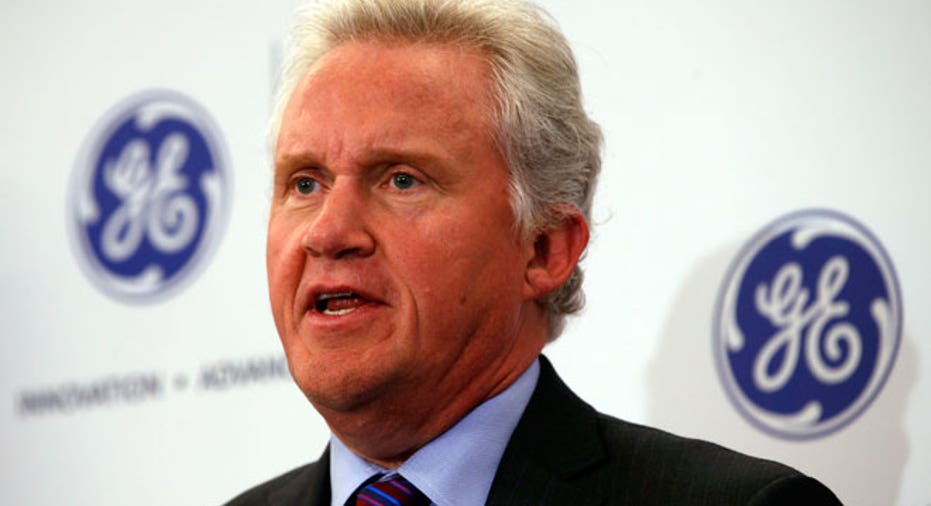Immet: GE Will Up Energy Spending to Aid Drilling Boom

General Electric Co (NYSE:GE) plans to intensify research focusing on complex energy projects such as waterless fracking and gas turbine efficiency by earmarking an additional $10 billion through 2020 for its "ecoimagination" budget.
The commitment, which represents roughly two years' research spending for the manufacturing giant, comes as General Electric responds to new opportunities created by the U.S. energy boom.
"The reserves are here. The potential is here," Chief Executive Jeff Immelt said on Monday, describing how new drilling technologies have unlocked vast oil and gas reserves.
Energy companies need help reaching fossil fuels but also bringing them to markets and GE can offer that know-how, the executive said.
"There's just technical intensity that is going into these industries," he said at a Bloomberg energy event in Washington.
Hydraulic fracturing, or fracking, has revolutionized energy development but the technique requires huge volumes of water to rattle oil and gas from deep underground.
The method is controversial as landowners and communities raise concerns about the safety of drinking water in energy patches and GE is trying to develop drill techniques that use gas rather than water, executives said.
Energy is the fastest growth area for GE as the global manufacturer works to become a dominant supplier of equipment and services to oil, natural gas and alternative power companies.
While GE doesn't forecast what it plans to spend on its main capital budget in future years, the new commitment gives investors a clue as to what the company's priorities will be into the next decade.
The "ecoimagination" project, which was formed in 2005 to broadly focus on sustainability and other environmental issues and has cost nearly $15 billion, had been set to expire next year. Executives are extending it to 2020 with the additional $10 billion.
While the overall goals of the project will remain, a larger percentage of the funds will go to energy-related projects, an acknowledgment of where Immelt and other executives see the future of the company Thomas Edison founded in 1892.
"We have a very broad, long-standing commitment to energy," said Mark Little, GE's chief technology officer and head of global research.
NEXT GENERATION FRACKING?
As part of the new focus, GE will study with Norway's Statoil <STL.OL> how to use carbon dioxide (CO2) in hydraulic fracturing - a process that mixes more than 2 million gallons of water per well with chemicals and sand to extract oil and natural gas.
The energy industry's copious use of water has put it into conflict with some residents in Texas, New Mexico and other arid states, and many companies have been trying to find ways to curb fracking's use of water, looking at using CO2 and even propane.
While CO2 fracking is not economical today, the companies hope to find a way to collect CO2 at the wellhead, recycle it, use it to frack again, then collect the CO2 and repeat the process, Little said.
"Ideally, we'd have a virtuous cycle going on," he said.
A key challenge will be to help the CO2 carry proppant, a type of sand that holds open the cracks in rock so oil and natural gas can escape, much like water does in current methods.
GE also wants to boost the efficiency of its natural gas-powered turbines to 65 percent from today's 62 percent. The company believes its existing research into jet engine efficiency could help significantly reach this goal, Little said.
COMPRESSED NATURAL GAS IN A BOX
The company plans to study how to make wind turbine blades cheaper and more efficient through the use of different composite materials, as well as expand its "CNG In A Box" product, which lets natural gas producers compress the fuel directly at the well to be used locally in engines.
The "ecoimagination" project is part of GE's larger research and development budget, worth roughly $5 billion to $6 billion per year.
A movement into energy is not new for GE, which last year bought Lufkin, aiming to sell the company's oilfield pumps in international shale fields and collect data to help oil producers become more efficient.
GE has also become of the world's largest wind turbine manufacturers since it bought Enron's wind business in bankruptcy.
(By Ernest Scheyder; Additional reporting by Patrick Rucker in Washington and Ed McAllister in New York; Editing by Terry Wade, Leslie Adler and Bernarrd Orr)



















